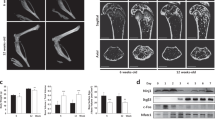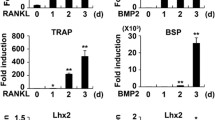Abstract
The receptor activator of nuclear factor-κB ligand (RANKL) is a key factor in regulating osteoclastogenesis and in maintaining the survival of mature osteoclasts. We screened differentially expressed genes in RAW264.7 cells in response to RANKL and found osteoclast stimulatory transmembrane protein (OC-STAMP) as one of the RANKL-induced genes of interest. Recently, OC-STAMP has been identified as the RANKL-induced protein that promotes osteoclast differentiation, but the mechanism that regulates its expression is not understood. Therefore, the tissue distribution of OC-STAMP and the signaling pathways that regulate its expression were studied here. Similar to osteoclasts, OC-STAMP was expressed in most tissues, suggesting its involvement in the function of other tissues. Interestingly, OC-STAMP was downregulated by 17β-estradiol at high concentrations, suggesting the potential relationship between OC-STAMP and estrogen. Importantly, the knockdown of OC-STAMP at the transcript level resulted in the inhibition of multinucleated osteoclast formation and the decreased expression of genes including transcription factor (such as c-Jun), receptors (such as RANK and c-Fms), a signaling molecule (such as TRAF6), and a cell fusion-related molecule (such as meltrin-α), suggesting that the osteoclast differentiation needs the coordinated expression of OC-STAMP with several molecules required for transcription, signaling transduction, and cell fusion. Additionally, the treatment of its specific antibody inhibited the formation and bone resorptive activity of mature osteoclasts, suggesting its involvement in the function of mature osteoclasts. Furthermore, studies with pharmacological inhibitors suggested PKCβ or Akt might be the major signaling molecules to regulate the expression of OC-STAMP during osteoclastogenesis.





Similar content being viewed by others
References
Abe E, Mocharla H, Yamate T, Taguchi Y, Manolagas SC (1999) Meltrin-alpha, a fusion protein involved in multinucleated giant cell and osteoclast formation. Calcif Tissue Int 64(6):508–515
Arai F, Miyamoto T, Ohneda O, Inada T, Sudo T, Brasel K, Miyata T, Anderson DM, Suda T (1999) Commitment and differentiation of osteoclast precursor cells by the sequential expression of c-Fms and receptor activator of nuclear factor kappaB (RANK) receptors. J Exp Med 190(12):1741–1754
Bai S, Kitaura H, Zhao H, Chen J, Müller JM, Schüle R, Darnay B, Novack DV, Ross FP, Teitelbaum SL (2005) FHL2 inhibits the activated osteoclast in a TRAF6-dependent manner. J Clin Invest 115(10):2742–2751
Bai S, Zha J, Zhao H, Ross FP, Teitelbaum SL (2008) Tumor necrosis factor receptor-associated factor 6 is an intranuclear transcriptional coactivator in osteoclasts. J Biol Chem 283(45):30861–30867
Boyle WJ, Simonet WS, Lacey DL (2003) Osteoclast differentiation and activation. Nature 423(6937):337–342
Bradley EW, Ruan MM, Vrable A, Oursler MJ (2008) Pathway crosstalk between Ras/Raf and PI3K in promotion of M-CSF-induced MEK/ERK-mediated osteoclast survival. J Cell Biochem 104(4):1439–1451
Darnay BG, Haridas V, Ni J, Moore PA, Aggarwal BB (1998) Characterization of the intracellular domain of receptor activator of NF-kappaB (RANK). Interaction with tumor necrosis factor receptor-associated factors and activation of NF-kappab and c-Jun N-terminal kinase. J Biol Chem 273(32):20551–20555
David JP, Sabapathy K, Hoffmann O, Idarraga MH, Wagner EF (2002) JNK1 modulates osteoclastogenesis through both c-Jun phosphorylation-dependent and -independent mechanisms. J Cell Sci 115(Pt 22):4317–4325
Fuller K, Wong B, Fox S, Choi Y, Chambers TJ (1998) TRANCE is necessary and sufficient for osteoblast-mediated activation of bone resorption in osteoclasts. J Exp Med 188(5):997–1001
Hotokezaka H, Sakai E, Kanaoka K, Saito K, Matsuo K, Kitaura H, Yoshida N, Nakayama K (2002) U0126 and PD98059, specific inhibitors of MEK, accelerate differentiation of RAW264.7 cells into osteoclast-like cells. J Biol Chem 277(49):47366–47372
Hotokezaka H, Sakai E, Ohara N, Hotokezaka Y, Gonzales C, Matsuo K, Fujimura Y, Yoshida N, Nakayama K (2007) Molecular analysis of RANKL-independent cell fusion of osteoclast-like cells induced by TNF-alpha, lipopolysaccharide, or peptidoglycan. J Cell Biochem 101(1):122–134
Ikeda F, Nishimura R, Matsubara T, Tanaka S, Inoue J, Reddy SV, Hata K, Yamashita K, Hiraga T, Watanabe T, Kukita T, Yoshioka K, Rao A, Yoneda T (2004) Critical roles of c-Jun signaling in regulation of NFAT family and RANKL-regulated osteoclast differentiation. J Clin Invest 114(4):475–484
Kaji K, Katogi R, Azuma Y, Naito A, Inoue JI, Kudo A (2001) Tumor necrosis factor alpha-induced osteoclastogenesis requires tumor necrosis factor receptor-associated factor 6. J Bone Miner Res 16(9):1593–1599
Kim YJ, Kwak CI, Gu YY, Hwang IT, Chun JY (2004a) Annealing control primer system for identification of differentially expressed genes on agarose gels. Biotechniques 36(3):424–426
Kim SH, Hong KO, Chung WY, Hwang JK, Park KK (2004b) Abrogation of cisplatin-induced hepatotoxicity in mice by xanthorrhizol is related to its effect on the regulation of gene transcription. Toxicol Appl Pharmacol 196(3):346–355
Kim K, Kim JH, Lee J, Jin HM, Lee SH, Fisher DE, Kook H, Kim KK, Choi Y, Kim N (2005) Nuclear factor of activated T cells c1 induces osteoclast-associated receptor gene expression during tumor necrosis factor-related activation-induced cytokine-mediated osteoclastogenesis. J Biol Chem 280(42):35209–35216
Kim K, Lee SH, Ha Kim J, Choi Y, Kim N (2008a) NFATc1 induces osteoclast fusion via up-regulation of Atp6v0d2 and the dendritic cell-specific transmembrane protein (DC-STAMP). Mol Endocrinol 22(1):176–185
Kim MH, Kim BT, Min YK, Kim SH (2008b) Profiling signalling pathways of the receptor activator of NF-kappaB ligand-induced osteoclast formation in mouse monocyte cells, RAW264.7. Amino Acids 34(3):497–506
Kim MH, Ryu SY, Choi JS, Min YK, Kim SH (2009) Saurolactam inhibits osteoclast differentiation and stimulates apoptosis of mature osteoclasts. J Cell Physiol 221(3):618–628
Kukita T, Wada N, Kukita A, Kakimoto T, Sandra F, Toh K, Nagata K, Iijima T, Horiuchi M, Matsusaki H, Hieshima K, Yoshie O, Nomiyama H (2004) RANKL-induced DC-STAMP is essential for osteoclastogenesis. J Exp Med 200(7):941–946
Lee ZH, Kim HH (2003) Signal transduction by receptor activator of nuclear factor kappa B in osteoclasts. Biochem Biophys Res Commun 305(2):211–214
Lee SE, Woo KM, Kim SY, Kim HM, Kwack K, Lee ZH, Kim HH (2002) The phosphatidylinositol 3-kinase, p38, and extracellular signal-regulated kinase pathways are involved in osteoclast differentiation. Bone 30(1):71–77
Lee SW, Kwak HB, Chung WJ, Cheong H, Kim HH, Lee ZH (2003) Participation of protein kinase C beta in osteoclast differentiation and function. Bone 32(3):217–227
Lee MS, Kim HS, Yeon JT, Choi SW, Chun CH, Kwak HB, Oh J (2009) GM-CSF regulates fusion of mononuclear osteoclasts into bone-resorbing osteoclasts by activating the Ras/ERK pathway. J Immunol 183(5):3390–3399
Livak KJ, Schmittgen TD (2001) Analysis of relative gene expression data using real-time quantitative PCR and the 2(-Delta Delta C(T)) method. Methods 25(4):402–408
Matsumoto M, Sudo T, Saito T, Osada H, Tsujimoto M (2000) Involvement of p38 mitogen-activated protein kinase signaling pathway in osteoclastogenesis mediated by receptor activator of NF-kappa B ligand (RANKL). J Biol Chem 275(40):31155–31161
NIH Consensus Development Panel on Osteoporosis Prevention, Diagnosis, and Therapy (2001) Osteoporosis prevention, diagnosis, and therapy. JAMA 285:785–795
Rho J, Altmann CR, Socci ND, Merkov L, Kim N, So H, Lee O, Takami M, Brivanlou AH, Choi Y (2002) Gene expression profiling of osteoclast differentiation by combined suppression subtractive hybridization (SSH) and cDNA microarray analysis. DNA Cell Biol 21(8):541–549
Root DE, Flaherty SP, Kelley BP, Stockwell BR (2003) Biological mechanism profiling using an annotated compound library. Chem Biol 10(9):881–892
Rozen S, Skaletsky HJ (2000) Primer3 on the WWW for general users and for biologist programmers. Methods Mol Biol 132:365–386
Sipos W, Pietschmann P, Rauner M, Kerschan-Schindl K, Patsch J (2009) Pathophysiology of osteoporosis. Wien Med Wochenschr 159(9–10):230–234
Takayanagi H, Kim S, Koga T, Nishina H, Isshiki M, Yoshida H, Saiura A, Isobe M, Yokochi T, Inoue J, Wagner EF, Mak TW, Kodama T, Taniguchi T (2002) Induction and activation of the transcription factor NFATc1 (NFAT2) integrate RANKL signaling in terminal differentiation of osteoclasts. Dev Cell 3(6):889–901
Wong BR, Josien R, Lee SY, Vologodskaia M, Steinman RM, Choi Y (1998) The TRAF family of signal transducers mediates NF-kappaB activation by the TRANCE receptor. J Biol Chem 273(43):28355–28359
Yagi M, Miyamoto T, Sawatani Y, Iwamoto K, Hosogane N, Fujita N, Morita K, Ninomiya K, Suzuki T, Miyamoto K, Oike Y, Takeya M, Toyama Y, Suda T (2005) DC-STAMP is essential for cell–cell fusion in osteoclasts and foreign body giant cells. J Exp Med 202(3):345–351
Yang G, Zaidi M, Zhang W, Zhu LL, Li J, Iqbal J, Varbanov A, Gross G, Phipps R, Troen BR, Sun L (2008a) Functional grouping of osteoclast genes revealed through microarray analysis. Biochem Biophys Res Commun 366(2):352–359
Yang M, Birnbaum MJ, MacKay CA, Mason-Savas A, Thompson B, Odgren PR (2008b) Osteoclast stimulatory transmembrane protein (OC-STAMP), a novel protein induced by RANKL that promotes osteoclast differentiation. J Cell Physiol 215(2):497–505
Yao Z, Li P, Zhang Q, Schwarz EM, Keng P, Arbini A, Boyce BF, Xing L (2006) Tumor necrosis factor-alpha increases circulating osteoclast precursor numbers by promoting their proliferation and differentiation in the bone marrow through up-regulation of c-Fms expression. J Biol Chem 281(17):11846–11855
Yavropoulou MP, Yovos JG (2008) Osteoclastogenesis-current knowledge and future perspectives. J Musculoskelet Neuronal Interact 8(3):204–216
Zhang Q, Fong CC, Zhang Y, Tzang CH, Fong WF, Yang M (2008) cDNA microarray analysis of the differentially expressed genes involved in murine pre-osteoclast RAW264.7 cells proliferation stimulated by dexamethasone. Life Sci 82(3–4):135–148
Acknowledgments
We thank Prof. Paul R. Odgren and Ms. Hong Jia (Department of Cell Biology, University of Massachusetts Medical School, Worcester, MA, USA) for providing OC-STAMP specific antibody. This study was supported by a grant from the Korea Healthcare Technology R&D Project, Ministry of Health, Welfare & Family Affairs, Republic of Korea (A084242).
Author information
Authors and Affiliations
Corresponding author
Rights and permissions
About this article
Cite this article
Kim, M.H., Park, M., Baek, Sh. et al. Molecules and signaling pathways involved in the expression of OC-STAMP during osteoclastogenesis. Amino Acids 40, 1447–1459 (2011). https://doi.org/10.1007/s00726-010-0755-4
Received:
Accepted:
Published:
Issue Date:
DOI: https://doi.org/10.1007/s00726-010-0755-4




